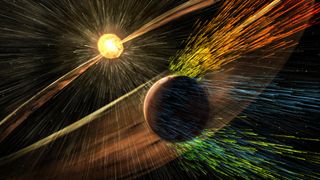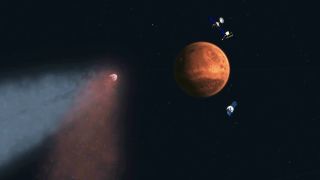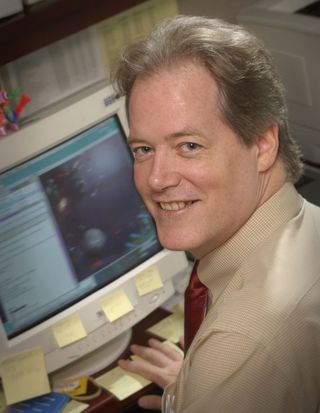Gravity Assist Podcast: Mars, with Bruce Jakosky and Michael Meyer
The Gravity Assist Podcast is hosted by NASA's Director of Planetary Science, Jim Green, who each week talks to some of the greatest planetary scientists on the planet, giving a guided tour through the Solar System and beyond in the process. This week, he is joined by the "man about Mars," Bruce Jakosky from the University of Colorado, who is the principal investigator of NASA's MAVEN mission, and Michael Meyer, NASA's lead Mars scientist.
You can listen to the full podcast here, or read the transcript below.

Jim Green: MAVEN was launched in 2013 to study the atmosphere of the Red Planet and how it interacts with the solar wind. So, what have you found out? [Missions to Mars: A Robot Red Planet Invasion History (Infographic)]
Bruce Jakosky: We've been looking at the way that sunlight and the solar wind hits Mars' upper atmosphere, driving gases from the atmosphere into space and stripping them from the planet. We've discovered that, over the long term, the solar wind has the ability to change Mars' climate by removing a large fraction of the gas from the atmosphere. This stripping of the atmosphere appears to be responsible for changing the planet from a warm, wet environment early in its history to the cold, dry environment we see today. That's a major change.
Jim Green: Can you describe how this atmospheric loss is taking place, from a global perspective?
Bruce Jakosky: We're seeing a lot of different processes taking place and all adding up. Hydrogen, for example, comes from water in the atmosphere, and hydrogen, [because it's] light enough, can just escape into space directly. Things like oxygen, which comes from water or from carbon dioxide in the atmosphere, are not light enough to just escape on their own. They need the solar wind to grab them and knock them out. So, we're seeing a lot of different processes, trying to understand how they play together. To me, what makes this exciting is that we're looking at the thin, tenuous part of the upper atmosphere — so thin that we would call that a vacuum if we were doing experiments here on Earth. Yet, that's where all the action is in affecting the climate at the surface of Mars and the ability of water to flow over the surface, controlling the degree to which Mars could have been habitable to microbes.
Jim Green: Some of the processes at Mars are unique in the sense that we don't experience them in and around Earth because of our strong magnetic field. What are you finding out about magnetic fields at Mars?
Get the Space.com Newsletter
Breaking space news, the latest updates on rocket launches, skywatching events and more!

Bruce Jakosky: We have a magnetometer in order to measure the properties of the solar wind [at Mars], and also what I call the morphology of how the solar wind interacts with the planet. It turns out that there are regions of the crust that have a magnetic field. Mars doesn't have a global magnetic field, but it has localized crustal magnetism, and those create little pockets of [magnetic] protection over the atmosphere where the solar wind can't hit them [because the magnetic field deflects the solar wind particles]. But they cover a very small fraction of the surface and, overall, we're seeing interactions between the solar wind and the ionosphere and the planet that have a significant effect.
Jim Green: Those bits of magnetic field are a remnant of Mars' ancient global magnetic field, and what really intrigues me about that remnant magnetic field trapped in Mars' crust is that what we are actually measuring is a hint of the past. What do you think happened to the magnetic field?
Bruce Jakosky: Well, you've got it exactly right. Mars appears to have had a strong global magnetic field early in its history and that magnetic field is recorded in the ancient crust. The younger crustal regions don't have it, so we think the magnetic field disappeared. The magnetic field on Earth is formed by motions within the molten iron core. You have an electrically-conducting material like metal, and it's moving, and it creates a magnetic field. Mars would have done the same thing early in its history, but when the magnetic field stopped, that must have indicated that the core froze and became solid. The Earth's core is still molten and still generating a magnetic field that we [experience] today, but Mars has stopped.
Jim Green: Here on Earth, one of the things that everyone knows is that our magnetic field helps organize particles, and we occasionally see aurorae when the Sun gets really active and hammers our magnetosphere. So, there's remnant magnetic fields on Mars, but does Mars have aurorae?
Bruce Jakosky: It does and, in many ways, it's more interesting than what we see on Earth. Of course I'm going to say that, because on Mars we don't have a magnetic field to stop the solar wind. The particles from the solar wind come in and can hit the atmosphere directly and we see aurorae generated by electrons that are hitting the atmosphere, and they're spread out over the whole planet rather than concentrated in northern and southern latitudes as on the Earth. In addition, we see aurorae generated by hydrogen hitting the atmosphere, and occasionally we see aurorae created as these particles from the Sun hit the crustal remnant magnetic fields and are focused into small regions, and that's the most analogous to aurorae on Earth because it's connected to the magnetic field. But most of the aurorae on Mars aren't connected to the magnetic field.

Jim Green: You know, one of the recent spectacular moments in planetary science was the passage of an Oort Cloud comet, C/2013 A1 (Siding Spring), by Mars in 2014. How did the comet affect Mars?
Bruce Jakosky: Well, let me start by telling you what we thought when we heard about Comet Siding Spring for the first time. It was discovered about a year and a half before MAVEN launched, and when it was initially discovered, they didn't know the orbit well enough. There was a chance it could hit Mars. My first reaction was, "Oh, my God, if it hits Mars and we're in orbit around it, the debris sent up by that impact would destroy our spacecraft."
Fortunately, as they learned more about the orbit, they knew it would pass close but not hit it [Mars]. The orbital dynamics were such that MAVEN would get there a month before the comet and there was nothing we could do about it.
We were worried about surviving the comet passage because of all this dust that comes off the comet, and we debated whether we should put extra shielding on the spacecraft. In the end, we did the thing that the engineers were most comfortable with, which was nothing. We took no precautions on the spacecraft, but operationally, we did. When we were in orbit around Mars, we timed where we were in our orbit so that we were shielded by the planet for about 20 minutes during the time of the peak dust flux to protect the spacecraft. For several hours we turned edge on to the flow of dust in order to minimize our cross-section so that less dust would hit us, and we survived. We couldn't even tell that there was a comet there from the [data from] spacecraft itself.
Jim Green: That must have been a spectacular event if you were standing on Mars, looking up at night, seeing the cometary material coming in like shooting stars.
Bruce Jakosky: We see on Earth meteor showers that are pretty spectacular, and they're left over from comets. To have a comet pass so close to Mars, only 140,000 kilometers away, and to have the coma of dust and gas hit the planet directly, it would have been a spectacular event to see.

Jim Green: I was delighted that all our spacecraft [in orbit around Mars] survived. But there are other objects in orbit around Mars that, I understand, MAVEN had to avoid. Can you tell us a little bit about your encounter with one of the moons?
Bruce Jakosky: Well, let me start with the difficulty we have in orbit because there are a lot of spacecraft, and their orbits evolve with time. Every now and then, the orbit of MAVEN will cross the orbit of one of the other spacecraft. We call those "COLA" seasons, (short for Collision Avoidance).
Occasionally, maybe once or twice a year, we have to do a maneuver to make sure we don't come too close to another spacecraft. But recently we had a collision opportunity —maybe that's the wrong way to put it — but a possibility that we would collide with the moon Phobos, and in that case the orbit predictions were such that we were definitely going to hit it if we didn't take action. We did a maneuver about five days in advance of that (predicted) collision in order to avoid it and we missed Phobos by about 200 kilometers. We have to constantly watch every day to make sure we're not going to hit something.
Jim Green: That's unbelievable. It's getting crowded at Mars, so to speak, but in a nice way. This is the way I like it.
Bruce Jakosky: Well, today there are five or six spacecraft in orbit: MAVEN, the Mars Reconnaissance Orbiter, Mars Odyssey, the Indian MOM (Mars Orbiter Mission), the European Space Agency's Mars Express and their recent addition, the Trace Gas Orbiter. These are the ones that are operating today. In addition, there are "dead" spacecraft — Mariner IX, Viking I, Viking II, the Russian Phobos Mission. All of these are in orbit and it's getting pretty crowded there.
Jim Green: I'm always interested in how we get into this business. For everybody I talk to, there's typically something that happens that gave them that "gravity assist" that propelled them into the science that they're doing. What was that like for you?
Bruce Jakosky: I was always interested in space, and I remember being a six-year-old sitting in front of the TV watching the countdown of the first Mercury astronauts in the very early 1960s. But, for me, what really sent me on this path was when I was an undergraduate at UCLA. I was a physics major, and I got bored with the classes because all they were doing was teaching us tools and techniques. So, I started looking around for something else and I took a planetary science class from Hugh Kieffer, who was one of the professors there. By the end of the semester, I had changed my major. I was working for him on the Viking mission, and that really sent me on this path. So, it happened to be one class that happened to be offered when I was looking around for something else to take.
Jim Green: Now that we've figured out how Mars lost its atmosphere with MAVEN, we can now talk about a couple of other Mars mysteries with Michael Meyer, our lead Mars scientist at NASA Headquarters. I'm really intrigued by some of the recent measurements of methane on Mars. Michael, what's going on?

Michael Meyer: As you might remember, a couple years ago, when we first started doing the methane measurements, there was all of a sudden — boom — this big spike in methane. And then, almost as surprising, it disappeared. You have to go through chemical gymnastics to get methane to show up and get methane to disappear. The atmospheric modelers are just in a tizzy over this because [we don't know] how is this possible?
Usually there is a low background of methane, which is fine because you can expect inputs from comet material to give us some methane. But then we found another spike and then [that spike] disappeared. We're not getting any correlation with anything else that's going on [on Mars] as we're exploring. So, this is a real mystery, and it is important because it could be a sign of geological processes where rock is interacting with water, where if you can pick the right rock, you get methane generated, and that would be an active geologic process going on, which would be really interesting.
[But on Earth], most of the methane that we see is a biological product. So, of course, that would obviously be very exciting on Mars, too. Either way, it's a mystery that needs to be solved because we have to figure out what the source is.

Jim Green: One of the more spectacular sets of observations that the Mars Reconnaissance Orbiter has been making are of the recurring slope lineae (RSL), and there's been some observations in and around Gale Crater that seem to indicate streaks coming down Mount Sharp, where the Curiosity rover is exploring. What's our current thinking about those?
Michael Meyer: Yeah, so recurring slope lineae — it's a mouthful for basically something that shows up seasonally. In the spring when it starts warming up, they appear. Through the summer, they get longer down a slope. In the fall, they start to disappear. In the winter, they're gone. And the next year, it happens again, and it happens in the same places, and it looks like water flowing down slopes. But, it's hard to explain that being water just because the temperatures are that low, there isn't that much [liquid] water on the surface of Mars at all because water's not stable on the surface. What's going on?
So, yeah, there have been a couple of candidate recurring slope lineae in Gale Crater, but they're not very good. I think we only have one or two where the jury's still out that they might be. But, we're finding them all around the [rest of the] planet. Mars Reconnaissance Orbiter has been doing a fantastic job of looking at the surface of Mars and seeing change. It's only because [the spacecraft has] been there for a while that it can see the seasonal progression and digression of each of these things.
One of the challenges and why they're still a mystery is when we're looking at the colors of these things to tell what the mineralogy is and what rocks there are, whether or not there's water there, our spectrometers are not really large enough to get a good spectra. So, we don't see a real change in the spectra over the seasons. [The RSL] go dark, they go light, and what's going on because you don't see it with our other instruments. But, we know it's real. We know that something's happening and we don't have a good explanation yet.

Jim Green: I think we've got to get up close and personal, really, to understand what's going on. So, I think that's in our future. We've got to go visit an RSL.
Michael Meyer: Well, certainly, for the candidate ones that we've been talking about in Gale Crater, we have marked out observation posts. So, there's spots as the Curiosity rover goes along. Way in the distance, it could see the candidate RSL and will image them, at high resolution, plus it has spectrometers. So we can get a different look at [the RSL]. Curiosity can look at it over better periods of time because the Mars Reconnaissance Orbiter can only see the RSL when it passes overhead. So, we have high hopes that, as we go along over the next year and we have these observation posts, we can watch [the RSL] and see whether or not this it is real, or is this like a shadow that shows up and disappears, or is it really something that's happening on the surface. And then because we can look at it with multi-colored eyes, we can get a better handle on what actually is the cause of the mechanism.
Jim Green: Curiosity's been doing fantastic and it's really being a pioneer, telling us that there are regions on Mars that could have been habitable in the past. That means the next mission, which right now we are calling 'Mars 2020', is going to have an opportunity to go to those places that Curiosity is uncovering for us that will enable that mission to make even greater progress. So, what's happening with Mars 2020?
Michael Meyer: You said it very well. I mean, Mars 2020 is really standing on the shoulders of Curiosity in a couple of different ways. One, it's using the whole architecture of the mission, including the entry, descent and landing, and the rover body itself that has worked so well that we're doing it again. We're adding brand new instruments, we're updating everything and it's going to cache samples, so that when it finds interesting rocks, we have the opportunity to bring them back.

The other way in which Mars 2020 is standing on the shoulders of Curiosity is that what Curiosity has learned has told us that Mars was habitable during the period of time that Gale Crater was formed, or soon after that. Some of the things about the mineralogy and the rocks tell us what the environment was like. So the instruments that we're sending on Mars 2020 are informed by that, and then picking the landing site for Mars 2020 is informed by what we've learned in Gale Crater and from information we got from orbit, so that when have much more sophisticated thinking about where we should go to get the right rocks that are going to tell us something about the early history of Mars during the period of time that life started on Earth, that life started in our Solar System.
Jim Green: We all get into this field in various ways. It's just fascinating to me to see how we just turn our attention to space. What was that "gravity assist" that pulled you into this science?
Michael Meyer: You know, it's a pretty tortuous route from me getting interested in science and actually ending up in the Mars program. I would say the first thing that really got me was that I'd been a fan of Jacques Cousteau, I liked the oceans, I had an aquarium. You know, I was interested in that. I liked to sail, I liked being on the water. Everybody likes being on the water. Then I got hired as a deckhand with a treasure salvaging operation off the coast of Florida. That, in and of itself, was pretty cool. The big thing was, after I was there for a couple of weeks, the head of the operation fired all the divers because they were just not doing the job. And so he asked me if I wanted to dive. Sure, I don't know how to dive, but I'd be happy to. So I got my opportunity to go scuba diving and help with the treasure salvaging.
There it was, my first foray into the subsurface, and I looked at this world, and despite all the TV shows I'd seen and the occasional book, I looked at this and I went, "My word, I don't know anything about this world. This is fantastic. Look at all this stuff." I was just blown away by how fantastic it was, even though I thought I knew a lot about the oceans.
That set me on the track of knowing I could do this for the rest of my life. Now, how I got to Mars is a whole different story, but [the oceans] got me interested in science and looking ahead beyond just going to college, to graduate school and realizing that I could actually make a living by learning things. It was great.
Jim Green: Thanks, Michael. Join us next time as we continue our virtual tour of the solar system. I'm Jim Green, and this is your gravity assist.
This story was provided by Astrobiology Magazine, a web-based publication sponsored by the NASA astrobiology program. This version of the story published on Space.com. Follow us @Spacedotcom, Facebook or Google+.
Join our Space Forums to keep talking space on the latest missions, night sky and more! And if you have a news tip, correction or comment, let us know at: community@space.com.

Astrobiology Magazine was an online popular science magazine from NASA's Goddard Space Flight Center. First published in 1999, Astrobiology Magazine hosted a vast archive of stories on science and nature topics relevant to space, innovation and biology, with an emphasis on the existence, detection and exploration of life in the universe. The magazine was created by Helen Matsos, who was chief editor and executive producer.

